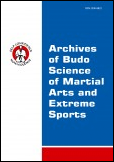2018, Volume 14, Issue 1
Teaching selected aikido techniques with the use of a rotating training simulator
Andrzej Mroczkowski1
1Faculty of Medicine and Health Science, University of Zielona Góra , Zielona Góra, Poland
Author for correspondence: Andrzej Mroczkowski; Faculty of Medicine and Health Science, University of Zielona Góra , Zielona Góra, Poland; email: a.mroczkowski@wlnz.uz.zgora.pl
Full text
Abstract
Background and Study Aim: Aikido belongs to martial arts with an exceptionally defensive character (the key to performing many aikido techniques is the proper use of the offender’s force). The force that causes the attacker to fall down is the net force of the centrifugal force affecting him and the force connected mainly with the defender’s body weight. A rotating training simulator is the device equipped with a special movable platform with handles that can be held with hands, and can be used to check the influence of positioning of body segments during the rotational movement, on achieving the centrifugal force. The aim of the research was to answer the questions: a) whether way the kind of manner of conducting aikido class can influence the efficiency of mastering aikido techniques; b) in what way biomechanical knowledge on the mechanics principles applied in aikido techniques, can impact the correctness of performance.
Material and Methods: The research included a 51-person group of students of physical education at stationary college, aged 22 to 26 years old. The students participated in aikido classes during their regular curriculum. They were randomly divided to group A (n = 24) students who additionally practiced on a rotational training simulator and group B (n = 27) students who learned aikido techniques only in a traditional fashion (based on performing a particular technique by imitating the coach’s movements). In group A, performing aikido techniques were explained using biomechanical knowledge. As soon as the students learned the way of safe falling necessary to practice aikido techniques, they were taught for the period of one month, four different aikido techniques. In these techniques the defender, using the dynamics of a rotational movement, neutralized the attack with a throw. The precision of performing each aikido technique was evaluated by means of a 10 point scale (focused on the effectiveness of execution of a particular sequence of movements, regardless of the tempo which was to be slowed down). The tempo of the attacker was adjusted so that the defender could execute all the successive movements of a particular technique within optimum time with regard to the individual abilities of the student. The students in group A were asked to write a test to evaluate their understanding of the mechanics of rotational movement.
Results: For the performance, group A scored much higher average value in comparison to group B (p<0.05). A relevant correlation was observed between answering the question correctly in the subject of biomechanics and the precision of performing aikido techniques (r = 0.74).
Conclusions: Using the rotational training simulator enabled quicker learning of aikido techniques. The students who understood better the mechanics of a rotational movement, also did better in performing the techniques. The aspect of that knowledge may have more meaning in the future, though PE teachers should understand precisely the principles of mechanics which describe rotational movement; they are responsible for the motor safety of students during e.g., doing gymnastic exercises with high-dynamic rotational movements – an improper movement can cause an unfortunate fall while performing the exercise).
Key words: rotational movement, motor safety, martial arts, Jigorō Kano, biomechanical phenomena





